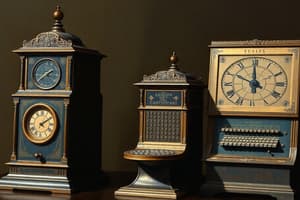Podcast
Questions and Answers
Who is credited with inventing the Jacquard Loom in 1801?
Who is credited with inventing the Jacquard Loom in 1801?
- Charles Babbage
- Ada Lovelace
- Joseph Marie Jacquard (correct)
- Lord Byron
What type of device was the Jacquard Loom primarily designed for?
What type of device was the Jacquard Loom primarily designed for?
- Transporting goods
- Weaving fabric patterns (correct)
- Performing complex calculations
- Automating agricultural tasks
What was Charles Babbage's envisioned power source for his calculating machine?
What was Charles Babbage's envisioned power source for his calculating machine?
- Wind
- Water
- Steam (correct)
- Electricity
Who wrote the world's first computer program inspired by Babbage's Analytical Engine?
Who wrote the world's first computer program inspired by Babbage's Analytical Engine?
Which English mathematician is considered one of the pioneers of computing?
Which English mathematician is considered one of the pioneers of computing?
Who is credited as the first computer programmer based on the text?
Who is credited as the first computer programmer based on the text?
Which of the following was the first large-scale automatic general-purpose mechanical analog computer?
Which of the following was the first large-scale automatic general-purpose mechanical analog computer?
In which field did women primarily hold roles as human computers in the early 20th century?
In which field did women primarily hold roles as human computers in the early 20th century?
Who submitted a grant proposal in 1937 to build the first electric-only computer?
Who submitted a grant proposal in 1937 to build the first electric-only computer?
Which individual introduced the concept of a universal machine that later laid the foundation for modern computing?
Which individual introduced the concept of a universal machine that later laid the foundation for modern computing?
Flashcards are hidden until you start studying
Study Notes
History of Computer: The Pre-Computing Era
The pre-computing era spans the centuries before the advent of electronically powered computers, encompassing a fascinating range of devices and advancements that paved the way for modern computing technology. This era saw the invention of various tools and techniques to aid in calculation and data processing, including mechanical calculators, punched card systems, and mechanical analog computers. Let's explore the key milestones and innovations that defined the pre-computing era.
Early Mechanical Calculators
One of the earliest examples of a pre-computing device is the Jacquard Loom, a French invention by Joseph Marie Jacquard in 1801. While primarily designed for weaving fabric patterns, it utilized punched wooden cards to automate the process, foreshadowing the use of punch cards in later mechanical calculating machines and early computers.
Charles Babbage and the Difference Engine
English mathematician Charles Babbage is considered one of the pioneers of computing. In 1822, he conceived of a steam-driven calculating machine, which he called the Difference Engine. Although the project failed to come to fruition during his lifetime, it marked the beginning of the quest for a machine that could perform complex calculations efficiently.
Punched Card Systems
In 1848, Ada Lovelace, the daughter of famed poet Lord Byron, wrote the world's first computer program inspired by Babbage's Analytical Engine. She also provided notes that expanded upon the technical aspects of the machine, effectively making her the first computer programmer.
Mechanical Analog Computers
Mechanical analog computers, such as Vannevar Bush's Differential Analyzer, were also instrumental in the pre-computing era. Developed in 1931, these machines relied on physical models rather than purely numerical calculations. The Differential Analyzer, built at the Massachusetts Institute of Technology (MIT), was the first large-scale automatic general-purpose mechanical analog computer.
Early Electronic Computers
As technology progressed, electronic computers began to emerge. In 1936, Alan Turing introduced the concept of a universal machine, later known as the Turing machine, which laid the foundation for modern computing. Turing's work was crucial in the development of stored-program computers and digital electronics.
John Vincent Atanasoff, a professor of physics and mathematics at Iowa State University, submitted a grant proposal in 1937 to build the first electric-only computer, without the need for gearing mechanisms. Although not successful in his attempt, Atanasoff's vision contributed significantly to the evolution of computer technology.
The Role of Women: Human Computers
By the early 20th century, women often held roles as human computers, responsible for manually performing complex calculations. They were integral to scientific research, particularly in fields like astronomy and meteorology.
These are just a few highlights from the pre-computing era, which lasted well into the 20th century. Despite the limitations of the technology available, these early innovations laid the groundwork for the rapid advances that would soon follow, culminating in the rise of electronic computers and the dawn of the digital age.
Studying That Suits You
Use AI to generate personalized quizzes and flashcards to suit your learning preferences.



